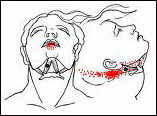This is a series on jaw pain and TMJ. If you missed the beginning, go back to Part 1. To locate the muscles, go back to Self-Treatment: Finding the bony landmarks. Link here for the NMT protocol. The following self-treatment is from my Neuromuscular Therapy center near Boston.
1. The digastric, suprahyoid group and platysma muscles are under the chin.
2. Which muscles do what?
3. Which muscles refer to the jaw?
4. A systemic perpetuating factor to note.
 The digastric can refer to the ear and throat, the angle of the jaw, but mostly to the mastoid process and back into the occiput. It has two “bellies” separated by a loop of connective tissue at your hyoid bone above your adams apple. To treat it, tuck your thumbs under the front of your chin and press there. To treat the attachment at the other end of the muscle, find the mastoid process behind your ear, accessed in the space under your ear behind your earlobe. Press on the front of it. To test your position, open your jaw. You should feel it move.
The digastric can refer to the ear and throat, the angle of the jaw, but mostly to the mastoid process and back into the occiput. It has two “bellies” separated by a loop of connective tissue at your hyoid bone above your adams apple. To treat it, tuck your thumbs under the front of your chin and press there. To treat the attachment at the other end of the muscle, find the mastoid process behind your ear, accessed in the space under your ear behind your earlobe. Press on the front of it. To test your position, open your jaw. You should feel it move.
To treat the “anterior belly” under your chin, you’ll need to go inside your mouth with one finger and press down against an opposing thumb positioned under your chin. Place the flat pad of your thumb under your chin parallel to the line of the jaw and press against it with the finger that’s inside your mouth.
The “posterior belly” is in the soft space right below the angle of your jaw. Press gently inward toward the back of your throat. If you feel your tonsils, stay above them.
Four other small suprahyoid muscles are in the same area, so you’ll get them as you treat the digastric.
The platysma is a thin flat superficial muscle under the skin of the front sides of your face and neck and down across your collar bone (clavicle). The best way to treat it is by stretching your chin up to the sky with your head back and your chin protruding.
The buccinator is the cheek muscle. You treat it with the masseter by compressing your cheek between your fingers against your thumb, pushing out from inside your mouth.
If you want to be thorough, finish your self-treatment with compressing and stretching the SCM and upper trapezius, both of which refer to the jaw.
Which muscles do what?
Opening: Digastric, suprahyoid group, lateral pterygoid (lower portion)
Closing: Masseter, temporalis, medial pterygoid
Deviation: Medial and lateral pterygoids, masseter, temporalis
Protrusion: Masseter (superficial portion), medial and lateral pterygoids
Retrusion: Deep masseter, posterior temporalis
Swallowing: Digastric, longus colli and capitis, medial pterygoid, buccinator
Which muscles refer pain to the jaw (Trigger Points)?
TMJ (temperomandibular joint): Medial and lateral pterygoids, deep masseter
Ear (into the ear and behind the ear): Digastric, SCM, longus capitis, deep masseter, medial pterygoid, upper trapezius. Stuffiness in the ear is from the medial pterygoid
Lower jaw (mandible): SCM, masseter, medial pterygoid, upper trapezius, platysma
Throat and front-of-neck: SCM, digastric, medial pterygoid
SCM and upper trapezius TrPs can activate satellite TrPs in the masseter
A Systemic Perpetuating Factor to note: Chronic infection and inflammation caused by gum disease, a mildly infected root, or a mouth infection can cause reflex muscle contractions.
This is the end of the jaw pain and TMJ series.